MENU
Skip menuResearch interests
Observations of cosmic large-scale structure have emerged as some of the richest probes for cosmology over the past few decades. Galaxy redshift-surveys are exploring ever larger fractions of the observable Universe and reveal it to be remarkably isotropic and homogeneous. Only on scales below ∼ 100 Mpc they find more complicated structures, known as the cosmic web consisting of gravitationally bound arrangements of dark matter, such as halos, filaments and sheets, which themselves host galaxies. Their statistical composition and spatial distribution contains a plethora of information about the origin and evolution of the Universe, but due to the nonlinear and stochastic nature of structure formation it is difficult to infer its underlying physical laws and parameters. Thanks to substantial efforts in theoretical and numerical studies, this task has become more and more procurable in modern-day cosmology. For the next generation of planned experiments, unprecedented precision measurements will demand firm predictions from theory. My aim is to tackle open problems in cosmology using either analytical, numerical, or observational methods. I am particularly interested in investigating the nature of dark energy and dark matter, measuring cosmological parameters, and testing Einstein's General Relativity (GR). Among the relevant observational missions in this field are both completed and planned experiments, such as BOSS, DES, EUCLID, LSST, and The Roman Space Telescope. Brief descriptions of some selected research projects I have been involved in are listed below.Cosmic Voids
Large-Scale Structure
Optimal weights – A major limitation on the fidelity of parameter constraints from large-scale structure is caused by the stochastic nature in the distribution of galaxies. On average, the density of galaxies follows the dark matter density field, multiplied by the so-called galaxy bias, a constant number on large scales. However, this relation is only satisfied in a statistical sense, with a significant scatter among different regions in the Universe. In previous studies with N-body simulations, my collaborators and I have developed an optimal mass-weighting scheme for galaxies to minimize this scatter [1,2]. We have shown that a remarkable noise suppression by up to two orders of magnitude is feasible (see Fig. 1).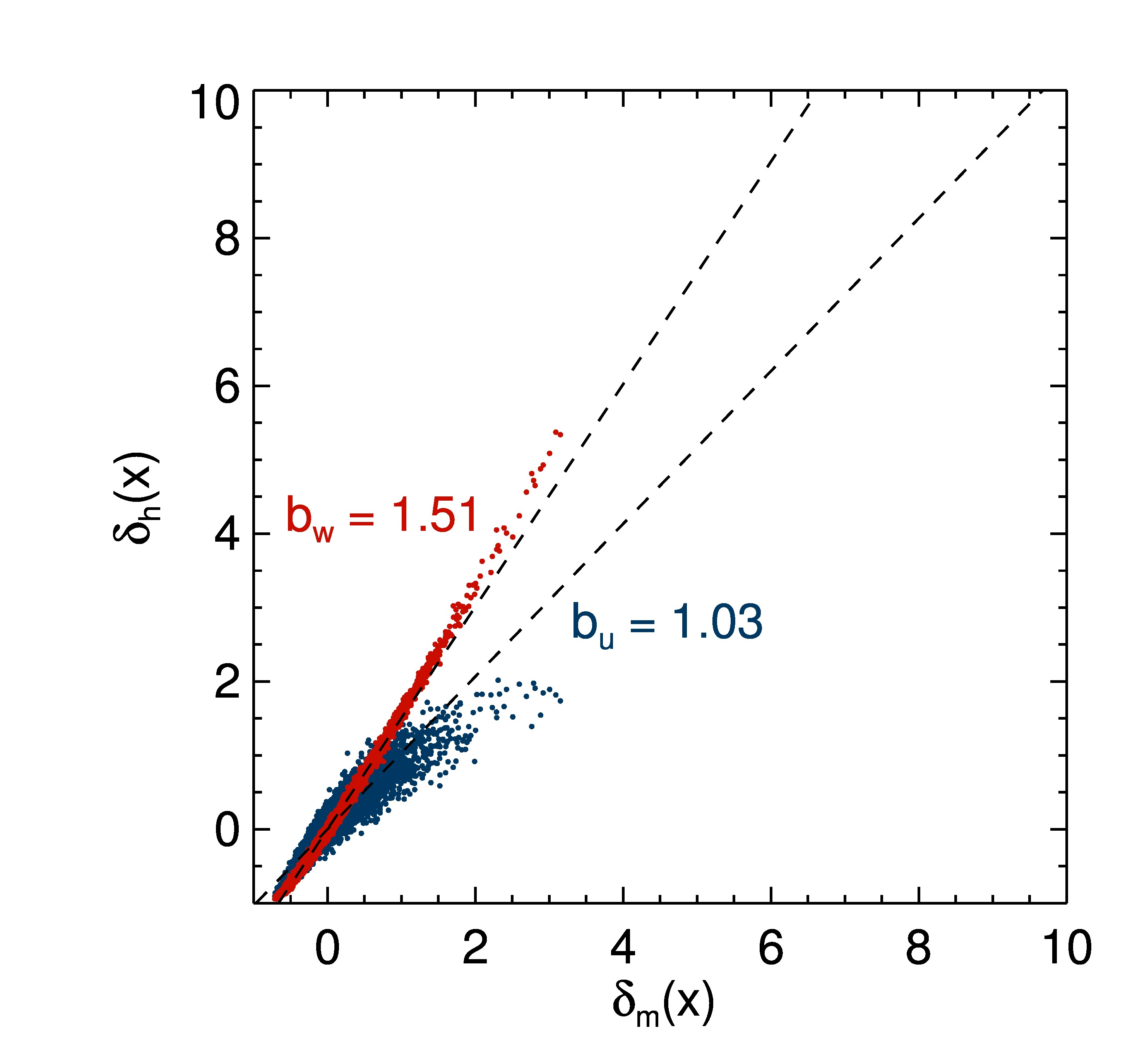
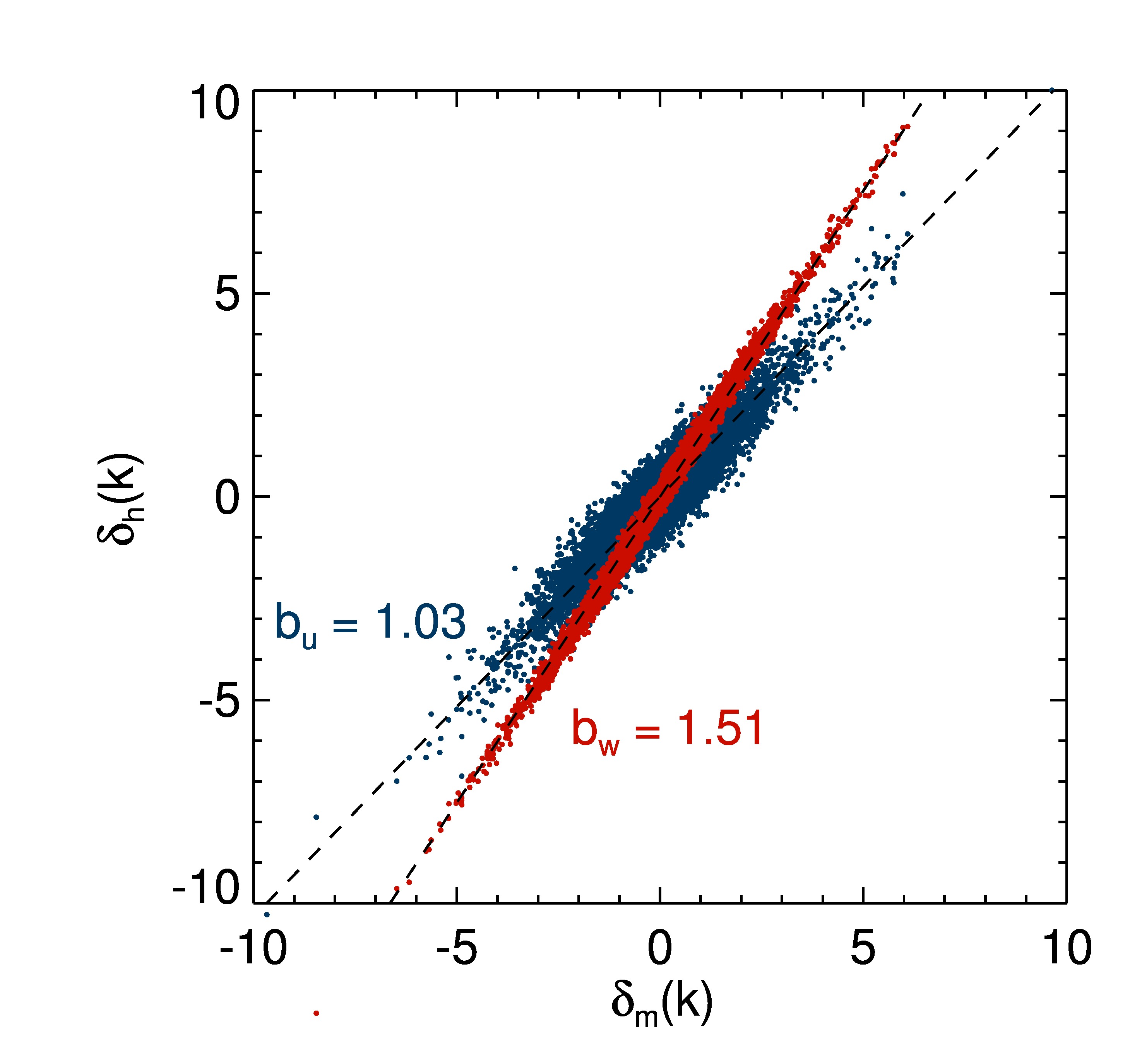
Fig. 1: Scatter between halo- and dark-matter overdensities in cells of 30 Mpc a side (left) and their Fourier components (right) from high-resolution N-body simulations. Blue depicts uniformly, red optimally weighted halos. Dashed lines show best-fit linear bias models with corresponding values [2].
Multiple tracers – Another restriction on the attainable accuracy on large-scale structure observables is due to cosmic variance. The Universe is a realization of a random process generated from quantum fluctuations in its early inflationary phase and we can only observe a possibly tiny fraction of its total volume. Hence, on large scales there is a low number of available Fourier modes to sample the density field of fluctuations, yielding a large uncertainty in its statistical representations (e.g. power spectrum or correlation function). However, a recent proposal suggests a way to circumvent this fundamental limitation using multiple tracers of the dark matter density field [3,4]. The quantity of interest in cosmology is not really the power spectrum and the like, it is the fundamental parameters that specify a cosmological model. Since different tracers (such as galaxies of different mass or luminosity) of the underlying density field all carry the same primordial fluctuations, a comparison of them can remove these fluctuations and the inherent characteristics of the tracers remain. This idea has been followed up in the literature with promising applications of different type, some of which are described below.
Primordial non-Gaussianity and constraints on inflation – The cosmological standard model assumes a single scalar field, the inflaton, to be the cause for an early inflationary phase of the Universe and predicts adiabatic Gaussian fluctuations with a nearly scale-invariant power spectrum. While observations of the cosmic microwave background (CMB) have so far supported this paradigm, there is still enough room for competing theories of the early universe. For example, the existence of multiple fields or the scenario of a cyclic Universe were shown to produce sufficiently large non-Gaussian features in the primordial fluctuation field that cannot be excluded from CMB data yet. Recently, large-scale structure has been shown to be a competitive indicator for primordial non-Gaussianity (PNG) as it induces a scale-dependent bias [5]. Specifically for the local type of PNG, my collaborators and me have demonstrated that an optimal large-scale structure analysis with the planned galaxy surveys will provide order-of-magnitude improvements on the current constraints [6] (see Fig. 2). A natural extension of this study would be to consider other forms of PNG, including non-local and scale-dependent models. In turn, this would open up the possibility to falsify models of inflation and to constrain the physics of the early Universe.
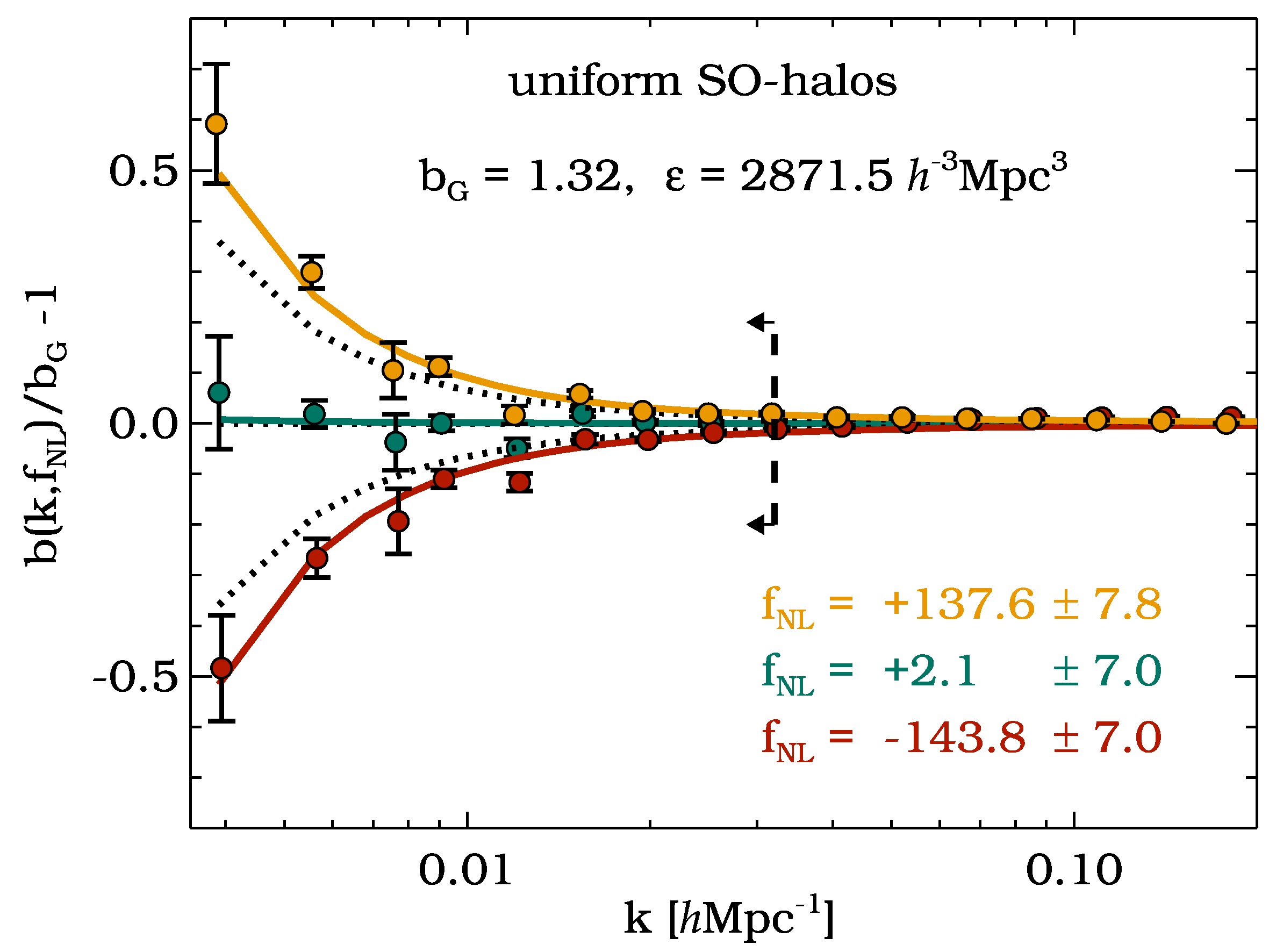
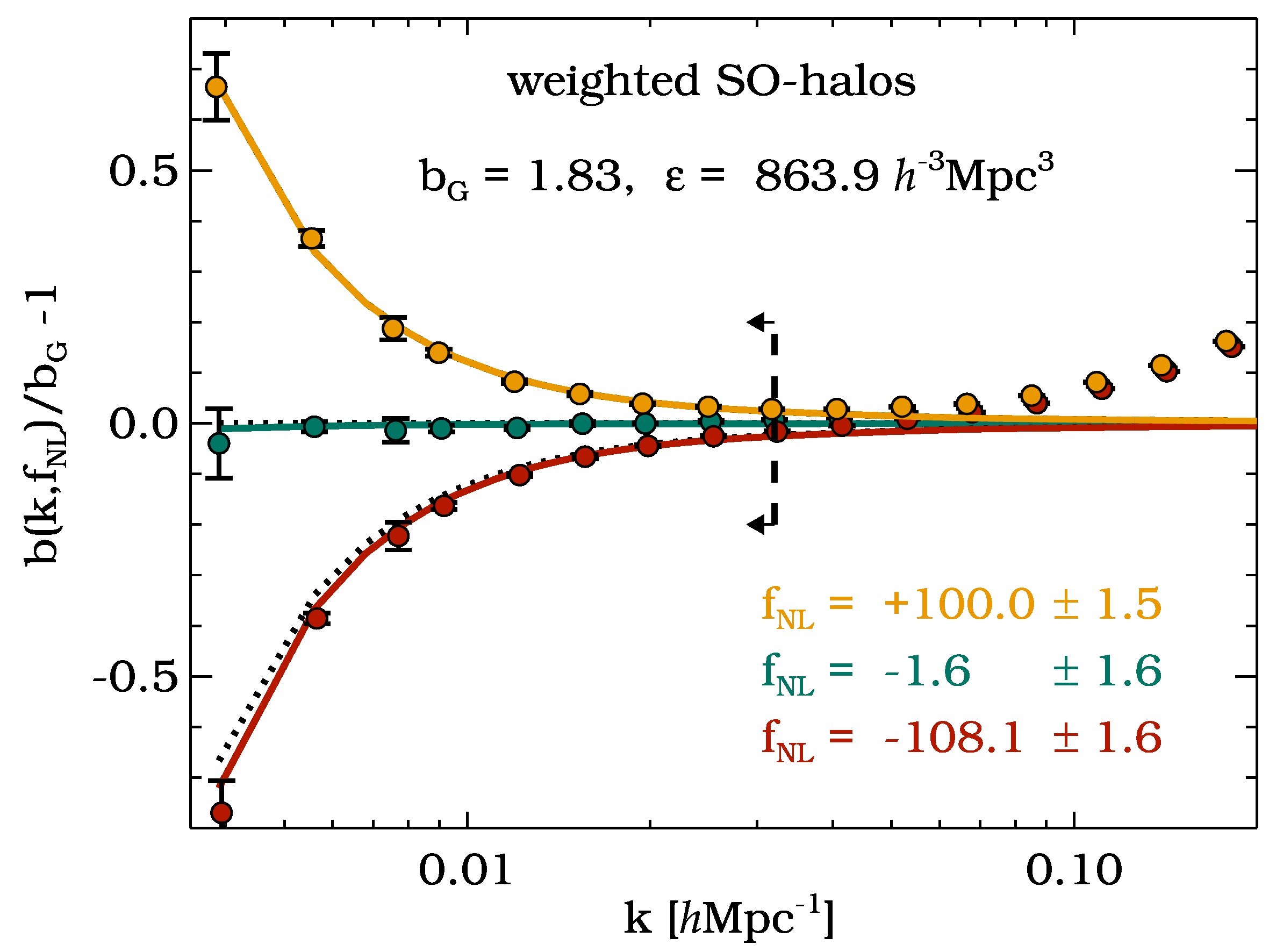
Fig. 2: Scale-dependent bias of uniformly weighted (left) and optimally weighted (right) dark matter halos from N-body simulations with Gaussian (fNL=0) and non-Gaussian (fNL=+-100) initial conditions. Solid lines show best-fit models with the corresponding parameters, dotted lines the fiducial models [6].
Redshift-space distortions and tests of gravity – The peculiar motion of galaxies causes extra anisotropic contributions to their clustering statistics. This is because the line-of-sight distance is inferred from their redshift, which has contributions from both Hubble expansion and Doppler shift. Instead of a contamination, these so-called redshift-space distortions (RSD) are considered as a valuable signal, since they probe the velocity field of galaxies acting as test-particles in the gravitational potential of the entire matter distribution. In order to exploit the cosmological implications from RSD, one has to possess a precise model that connects the velocity distribution of galaxies to their clustering statistics in redshift space. Although lots of efforts have been undertaken in this direction, satisfactory agreement between perturbation theory and simulations could so far only be achieved from the linear to the mildly nonlinear regime at scales above ~ 50 Mpc. From the observational side it is desirable to have working models at even smaller scales, because the informative value of clustering statistics on large scales is limited due to cosmic variance. On the basis of N-body simulations, we have investigated the benefits of optimal weighting and multi-tracer methods for improvements on RSD-parameter constraints (see Fig. 3). With a model for RSD one can determine galaxy velocities in a statistical manner and from that infer the gravitational potential. If done accurately enough, various classes of modified gravity theories can be tested on cosmological scales, where only relatively weak constraints exist so far. We demonstrated that the accuracy on such constraints can be improved considerably with our methods [7,8].
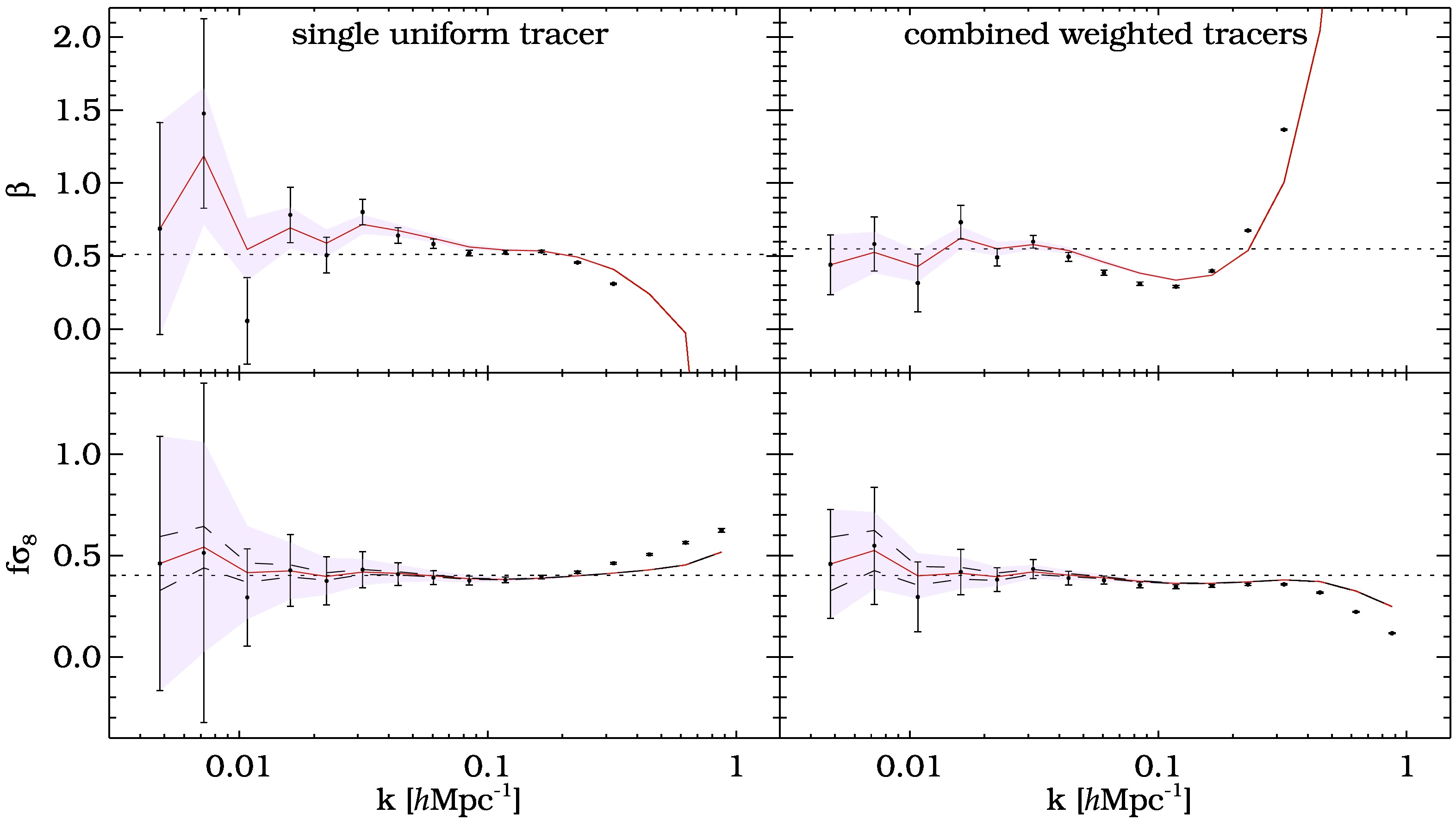
Fig. 3: Constraints on RSD parameters using a single uniformly weighted tracer (left), and multiple optimally weighted tracers (right) from N-body simulations [7].
References
[1] U. Seljak, N. Hamaus, and V. Desjacques. "How to Suppress the Shot Noise in Galaxy Surveys". Phys. Rev. Lett., 103(9):091303, August 2009. [2] N. Hamaus, U. Seljak, V. Desjacques, R. E. Smith, and T. Baldauf. "Minimizing the stochasticity of halos in large-scale structure surveys". Phys. Rev. D, 82(4):043515, August 2010. [3] P. McDonald, and U. Seljak. "How to evade the sample variance limit on measurements of redshift-space distortions". J. Cosmol. Astropart. Phys., 10:007, October 2009. [4] U. Seljak. "Extracting Primordial Non-Gaussianity without Cosmic Variance". Phys. Rev. Lett., 102(2):021302, January 2009. [5] A. Slosar, C. Hirata, U. Seljak, S. Ho, and N. Padmanabhan. "Constraints on local primordial non-Gaussianity from large scale structure". J. Cosmol. Astropart. Phys., 8:031, August 2008. [6] N. Hamaus, U. Seljak, and V. Desjacques. "Optimal constraints on local primordial non-Gaussianity from the two-point statistics of large-scale structure". Phys. Rev. D, 84(8):083509, October 2011. [7] N. Hamaus, U. Seljak, and V. Desjacques. "Optimal weighting in galaxy surveys: Application to redshift-space distortions". Phys. Rev. D, 86(10):103513, November 2012. [8] J. Yoo, N. Hamaus, U. Seljak, and M. Zaldarriaga. "Going beyond the Kaiser redshift-space distortion formula: A full general relativistic account of the effects and their detectability in galaxy clustering". Phys. Rev. D, 86(6):063514, September 2012.